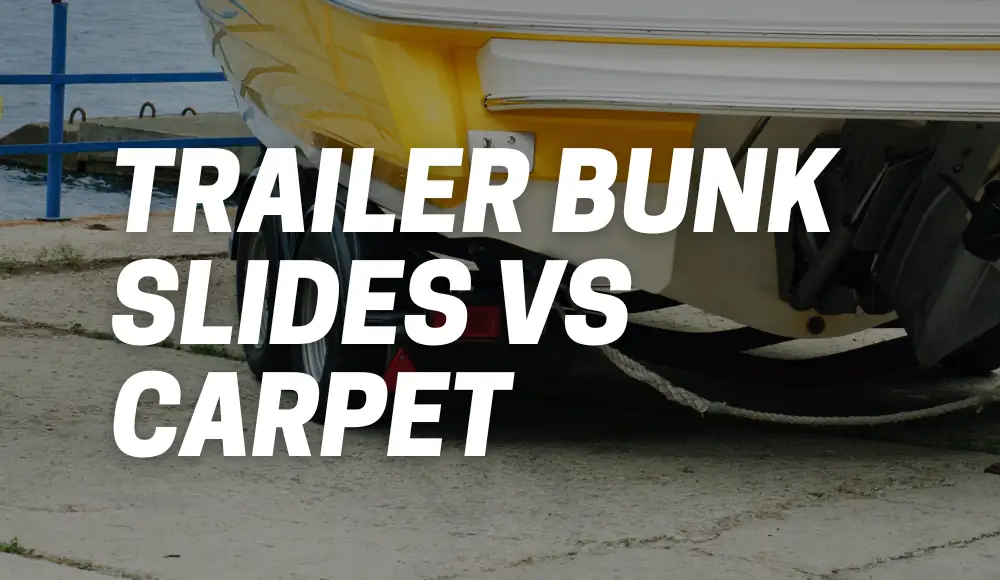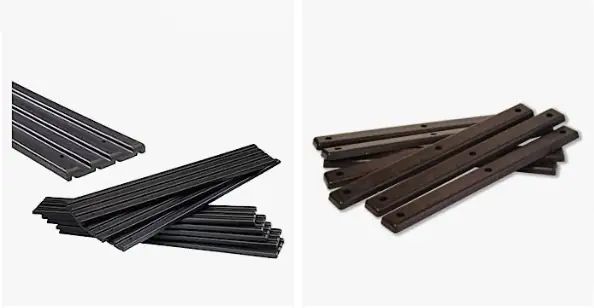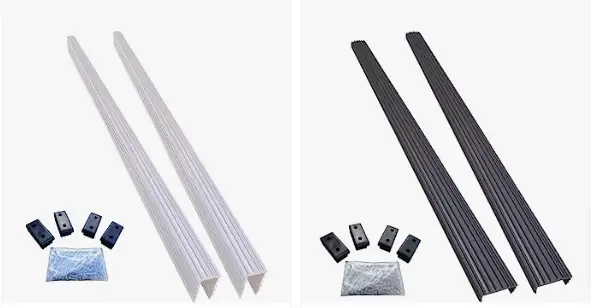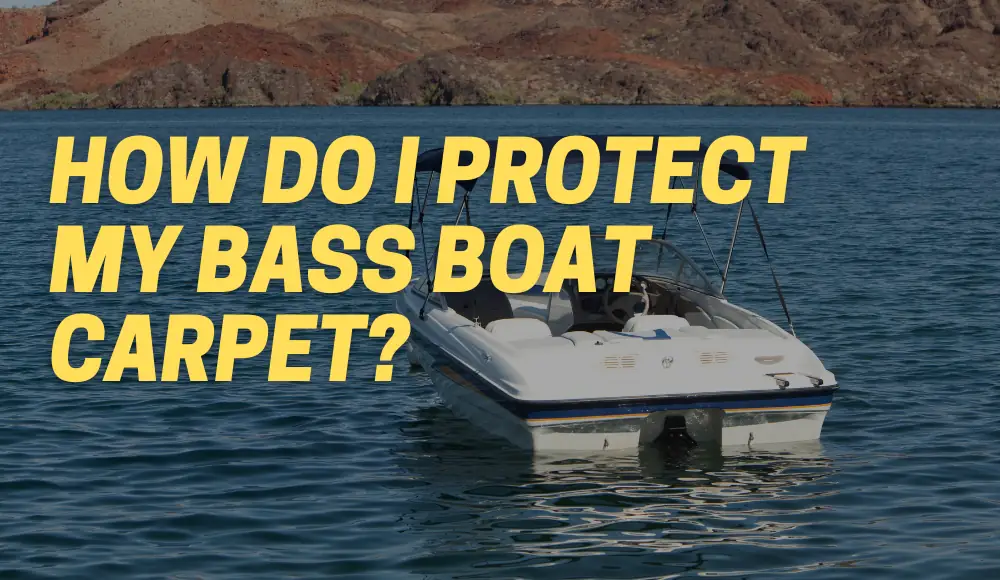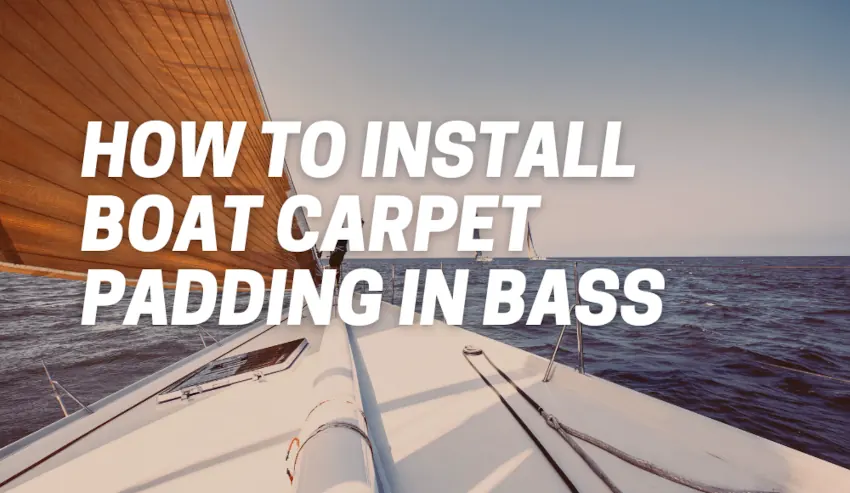When it comes to maintaining and protecting your boat or personal watercraft, paying attention to the trailer bunks is crucial. These bunks provide essential support and protection during transportation and launching. One common consideration is whether to use trailer bunk slides vs carpet.
In this article, we will examine the pros and cons of each option to help you make an informed decision.
Let’s start by answering the question: do you need carpet on trailer bunks?
Do You Need Carpet on Trailer Bunks?
First things first. Why do boat trailers have carpet?
Carpeting your trailer bunks offers several benefits, making it a popular choice for boat owners. The carpet acts as a protective barrier between the boat hull and the bunk, preventing scratches and damage during loading and unloading.
Additionally, the carpet provides a cushioning effect, reducing the risk of hull distortion and potential damage caused by constant rubbing against hard surfaces.
What Kind of Carpet is Used on Trailer Bunks?
Choosing the right carpet for your trailer bunks is essential to ensure longevity and effectiveness.
Marine-grade carpet is the preferred option as it is specifically designed for outdoor use and can withstand exposure to water and sunlight without deteriorating.
This type of carpet is typically made from synthetic fibers such as polypropylene, which resists mold, mildew, and rot.
What Size Carpet for 2×6 Bunks?
For 2×6 bunks, it is recommended to use a carpet that is wider than the bunk itself. This allows for better coverage and ensures the boat hull comes into contact with the carpet, rather than the bunk directly.
A common size for trailer bunk carpet is 18 inches wide, providing ample coverage for the bunk and additional protection for your boat.
What is the Best Material for Trailer Bunks?
When it comes to the best material for trailer bunks, it ultimately depends on your specific needs and preferences.
While carpet is a popular choice, there are other materials to consider as well.
One option is using plastic or composite bunk slides. These slides are typically made from high-density polyethylene (HDPE) and offer a low-friction surface that allows the boat to slide smoothly onto the trailer. They are durable, require minimal maintenance, and can last for a long time.
Trailer Bunk Slides vs Carpet: User Advice
Here is a table summarizing the main points from the Internet regarding trailer bunk slides vs carpet shared by boat owners:
| Main Point |
|---|
| Plastic pads like Teflon may cause the boat to slide off the trailer, risking accidents and damage. |
| Teflon strips are slick, and the boat should be unhooked before backing down to prevent accidents. |
| Silicone spray on carpet makes the boat slide off easier, but the boat should be backed into the water before unhooking due to the slickness of the spray. |
| Carpet provides more grip, reducing the risk of accidents in various scenarios. |
| Using old fire hose instead of carpet can be a durable alternative, but it may not be visually appealing. |
| Plastic sections or pads can be used instead of carpet, reducing the risk of rot and rust. |
| Teflon on aluminum i-beams can work well, but it is advised to stay hooked until the boat is partially in the water to prevent accidents. |
| Silicone spray on carpet can make the boat slide off almost like Teflon pads. |
| Summary |
|---|
| Suggests using dry lube Teflon spray on the carpet to make it slicker for easier boat launching. |
| Provides suggestions for resolving the boat settling and alignment issues during loading. |
| Proposes using synthetic deck board material for the trailer bunks. |
| Suggests using Dawn dish soap on the carpet as a cheaper alternative. |
| Recommends replacing the bunk carpet with plastic covers, which make boat sliding easier but require securing the boat well during towing. |
| Shares positive experience with Surfix bunk slides as a significant improvement. |
| Provides positive feedback on Surfix bunk slides’ weight handling and minimal paint scuffing. |
| Mentions using plastic covers as an alternative to carpet and advises tying down the boat properly. |
| Shares the installation of Caliber Marine Slides and their compatibility with a 5,000 lbs boat. |
| Recommends Marykate Liquid Rollers for bunk renovation. |
| Shares positive experience with carpet bunk covers lasting 12 years in saltwater but expresses curiosity about plastic bunks. |
| Recommends nylon runners as a handy alternative to carpet for easy boat sliding. |
| Describes the installation of plastic covers and strips for easier boat sliding and future plans to replace carpeted bunks with cypress. |
| Expresses concerns about plastic bunk covers causing gel coat wear if the boat is not securely tied down. Recommends proper tie-down for prevention. |
—
DIY Trailer Bunk Slides
If you decide to go with trailer bunk slides, you’ll be pleased to know that installing them can be a straightforward do-it-yourself (DIY) project.
Here’s a step-by-step guide to help you get started:
- Measure the Bunks: Begin by measuring the length and width of your trailer bunks. This information will help you determine the size and quantity of bunk slides required.
- Choose the Bunk Slide Material: Select the appropriate bunk slide material based on your needs and budget. As mentioned earlier, HDPE bunk slides are a popular choice due to their durability and low-friction properties.
- Cut the Bunk Slides: Using a saw or appropriate cutting tool, cut the bunk slides to match the length of your trailer bunks. Make sure the edges are smooth to avoid any potential damage to your boat hull.
- Secure the Bunk Slides: Attach the bunk slides to the trailer bunks using screws or other suitable fasteners. Ensure that the bunk slides are securely fastened to provide reliable support.
Best Boat Trailer Bunk Slides
When it comes to selecting the best boat trailer bunk slides, it’s important to consider factors such as durability, ease of installation, and the specific needs of your boat. Here are a few popular options to consider:
- Tie Down Engineering Bunk Slicks: These bunk slicks are made from ultra-high-molecular-weight (UHMW) polyethylene, offering exceptional durability and longevity. They provide a smooth surface for your boat to slide on, reducing friction and potential hull damage.
- Gatorbak Synthetic Bunk Covers: These bunk covers are made from a combination of synthetic materials that provide both durability and enhanced protection for your boat. They are designed to resist the effects of water, sunlight, and harsh weather conditions.
- Surfix Trailer Bunk Glides: Surfix Trailer Bunk Glides are made from a high-density polyethylene (HDPE) material, which provides a low-friction surface that allows the boat to slide smoothly onto the trailer. These glides are specifically engineered to reduce friction and resistance, making it easier to launch and retrieve boats.
Tie Down Engineering Bunk Slicks
Gatorbak Synthetic Bunk Covers
Surfix Trailer Bunk Glides
How Can I Make My Trailer Bunks More Comfortable?
While trailer bunk slides offer a low-friction surface for loading and unloading, some boat owners prefer to enhance the comfort of their trailer bunks further. Here are a few tips to make your trailer bunks more comfortable:
- Use Padding: Consider adding additional padding to the trailer bunks. This can be achieved by using foam pads or cushions designed for this purpose. Ensure that the padding is securely fastened to prevent movement during transportation.
- Opt for Carpeted Bunk Slides: If you prefer the benefits of both carpet and bunk slides, you can opt for carpeted bunk slides. These slides combine the low-friction properties of bunk slides with the protective cushioning of carpet, offering the best of both worlds.
FAQs
How Do You Make Trailer Bunks Slippery?
If you’re looking to make your trailer bunks slippery, there are a few options to consider. One approach is to use a boat hull lubricant or silicone spray specifically designed for this purpose. Apply the lubricant to the trailer bunks, ensuring an even coating, to reduce friction and facilitate smooth boat loading and unloading.
Should Trailer Bunk Carpet be Glued?
While it is not necessary to glue trailer bunk carpet, some boat owners choose to do so for added security and longevity. If you decide to glue the carpet, ensure that you use a marine-grade adhesive suitable for outdoor use. Follow the manufacturer’s instructions for proper application and allow sufficient drying time before using the trailer.
Conclusion
Whether you choose trailer bunk slides or carpet for your boat trailer bunks, it’s important to consider the specific needs of your boat and your preferences.
Both options offer unique benefits, and by understanding their pros and cons, you can make an informed decision that best suits your requirements.
Remember to prioritize the protection and support of your boat during transportation to ensure a safe and enjoyable boating experience.
